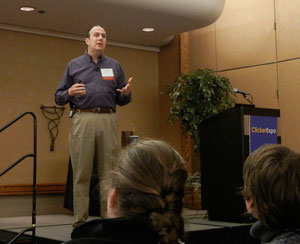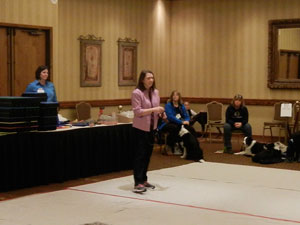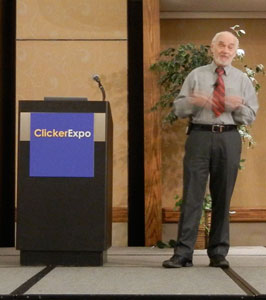Always learning
I attend ClickerExpo regularly, and one of my favorite parts of the conference is discovering Sessions that are new, or at least new to me. In this blog post, I'd like to share some of the new experiences I had at ClickerExpo 2012. One was Ken Ramirez's brand-new Session and Lab titled 1+1=3: Adduction & Combining Cues. Another was Michele Pouliot's Session and Lab Hold It, Get It, Bring It, Give It! The Multi-Purpose Clicked Retrieve.
In addition to these marvelous Sessions, Saturday and Sunday provided two different opportunities to hear the great Dr. Jaak Panksepp, a neuroscientist mentioned in Karen Pryor's book, Reaching the Animal Mind.

1+1=3: Adduction & Combining Cues
Adduction combines two existing cues to create a new behavior. For example, cueing your dog to spin and then cueing a bark while your dog is spinning can create the new behavior of barking while spinning. There are several different types of adduction, and Ken Ramirez (KR) focused on three of them. The example I provided above is what KR called "additive adduction." Another, somewhat more advanced, option is what KR calls "conceptual adduction."
KR described two types of conceptual adduction: "AND" and "THEN." In AND, several cues are given with the intention of creating a combined behavior. These cues can be given simultaneously or sequentially (as described below). The other type of conceptual adduction KR discussed is "THEN," in which several cues are given and then the animal is released to perform the cued behaviors one after another, in the order in which the cues were given.
AND conceptual adduction can be relatively easy to achieve in the beginning stages, since you can cue the animal using different types of cues, such as verbal and visual, simultaneously. Another alternative for AND, which can be better in the long run, is to give several cues in a row while the animal is cued to wait (meaning "await the go signal"), after which the animal is released to do the combined behavior.

An example of AND would be cueing a dog to "come" while also cueing "down," so that the dog would crawl. Another way to achieve this combination in an AND context would be to cue the dog to wait for cues, then verbally cue "down… come," and then give the release cue. Once released, the dog should start crawling to you.
With THEN conceptual adduction there is no simultaneous cueing option, so it is imperative to train a wait and release. An example of THEN adduction would be cueing a dolphin to go to a station and then vocalize. The trainer would begin by putting the dolphin in a wait, then cue "station…vocalize," and then give the release cue. Once released, the dolphin should go to the station (quietly) and begin vocalizing after arriving there.
Adduction can be a fun training puzzle for an advanced trainer with an advanced learner. It's important to remember, however, that adduction (especially conceptual adduction) is a challenge that may take some time for an animal to grasp. The difficulty of the puzzle is increased by the physical complexity of combining certain behaviors. For example, when you cue "down" AND "come," your dog must figure out how to crawl, which may not be in the dog's current physical repertoire.
To view captions and watch video in full screen
mode, click the full screen button located at the far
bottom-right corner of the video.
KPCT and ClickerExpo, all rights reserved to KPCT.
The full content of Ken's presentation is too complex to summarize in a short blog post, so my description is meant as only an overview, not a training plan. Since a picture is said to be worth a thousand words, I am including some photos and videos from the Lab on this topic. The first photograph shows Heather Lawson teaching her dog, Tag, a "wait" position (a position from which he will eventually listen to multiple cues before being released to perform them), while coaches Lynn Martin and Megan Cruz look on.
The first video shows Greta Kaplan demonstrating her progress on two different behaviors with her dog, HiQ Mind Meld (Mellie), while Ken Ramirez observes. The first behavior is "paw lift" AND "stand." The second is "sit" AND "back up." These examples are probably additive adduction, rather than pure AND adduction, since Mellie and Greta are both new to this task. Nevertheless, what they achieve is quite impressive.
To view captions and watch video in full screen
mode, click the full screen button located at the far
bottom-right corner of the video.
KPCT and ClickerExpo, all rights reserved to KPCT.
This second video shows Kim Collins and her dog, Bounce, demonstrating their work on a "left paw lift" AND "right paw lift." Since Kim uses hand signals for both of these behaviors, she asks her friend Sylvie Fefer to click for her. This video clip demonstrates how much problem-solving by the animal is required in this type of training. Bounce really wants to do the task, but is having difficulty figuring out how to lift his right paw while also lifting his left paw.
For more information about adduction, contact Ken Ramirez.
Hold It, Get it, Bring It, Give It! The Multi-Purpose Clicked Retrieve
Another highlight of my weekend was Michele Pouliot's (MP's) Session Hold It, Get it, Bring It, Give It! The Multi-Purpose Clicked Retrieve. This Session provided detailed information on a proven method for teaching a reliable retrieve, and the Lab following it demonstrated how effective the method is even with novice dogs.
Briefly, MP's method involves the following steps:

- Dog interacts with article (including looking at it, pawing at it, etc.)
- Dog nose targets article
- Dog interacts with article using mouth
- Dog closes mouth on article
- Dog achieves duration hold of article
- Handler removes hands briefly from article during hold and then returns them, while dog maintains hold
- Dog moves held article towards handler's waiting hands
- Dog maintains duration hold of article while it is in handler's hands
- Dog takes article as handler places article progressively lower, until article is on ground (handler's hands still on article)
- Handler places article on ground and removes hands, after which dog picks up article and moves it to handler's hands
- Dog waits (or is held), facing same direction as handler, while article is dropped or tossed. Dog is released, picks up article, and returns it to handler's waiting hands
- Dog waits (or is held) facing handler, while article is dropped or tossed. Dog is released, picks up article, and returns it to handler's waiting hands.
From here, the training is a matter of varying tossing distance and direction, adding a cue to the retrieve (and if desired, the hold), and teaching a formal release cue. Once these steps are completed with one article, additional retrieve articles can be introduced. Each new article should be trained from the beginning of the protocol, even if the dog has already learned multiple articles.
The best retrieves happen when the animal is really thrilled about the process, which is why MP spends so much time classically conditioning the article being retrieved before she asks the dog to start doing anything resembling a full retrieve. MP also encourages handlers to increase the value of the retrieve article by limiting the dog's access to it both between and during training sessions (the article is kept out of sight between repetitions as well as during time off from training).
To view captions and watch video in full screen
mode, click the full screen button located at the far
bottom-right corner of the video.
KPCT and ClickerExpo, all rights reserved to KPCT.
Like all good methods for teaching a retrieve, MP's method is back-chained. MP spends a great deal of time on the last step (the dog delivering the article to the handler), and only adds the "earlier" steps of going to and retrieving the article toward the end of her training. Since most retrieves fail because the duration hold is not adequate, MP's protocol also includes tips for how best to achieve and maintain a duration hold.
The Lab associated with MP's learning Session on this topic had 16 dog teams, and all of them did extremely well. This video shows the progress one team, Lisa Moore and Tait, made in just a few training sessions. The first training session you see is actually Lisa and Tait's second session (the first focused mostly on looking at the article). The second session on the video is their fourth session (two short sessions later), where they have progressed past mouth-related behavior to Tait's closing his mouth on the article.
For more information on clicked retrieve, contact Michele Pouliot.
Reaching the Animal and Human Mind

One of the great thrills at every ClickerExpo is finding out which amazing speaker Karen Pryor has invited to speak at the banquet dinner and at the conference close. The ClickerExpo Portland 2012 speaker was none other than Dr. Jaak Panksepp, known by many through his video discussing laughter in rats. While his talk on the nature and origin of the mind is too complex to describe completely, I would like to mention a few of the thoughts Dr. Panksepp shared.
- Emotional behavior reflects emotional feelings. This means, among other things, that Dr. Panksepp and those who follow him believe that animals have feelings.
- Like humans, non-human animals (at least mammals) seem to have seven major basic emotions. Dr. Panksepp calls these SEEKING (the appetitive urge), RAGE, FEAR, LUST, CARE (nurturing), PANIC (separation distress, grief), and PLAY (joy).
- SEEKING is the system clicker trainers appear to hook in to. SEEKING is a very pleasurable emotional system, which, as Karen Pryor pointed out in Reaching the Animal Mind, may explain why clicker trained animals seem to be having so much fun.
- Dr. Panksepp also spoke of the importance of the basic emotion CARE. He said that our work with animals is successful because we care about the animals we train.
- Dr. Panksepp's research (for a somewhat unrelated purpose) has incidentally demonstrated a phenomenon that many trainers may already have noted: Dogs wag their tails more when they are anticipating a treat, and slow their wagging as they receive the treat. While Dr. Panksepp does not yet have research data to back this up, he believes the phenomenon occurs because the SEEKING circuit is operating during the anticipation phase, but not once the reinforcer is given. As mentioned before, SEEKING is a highly enjoyable state. In SEEKING, parts of the brain that trigger happy vocalizations in rats are active. It seems likely that parts of the brain that trigger happy tail wagging in dogs are also active during SEEKING behavior.
- PLAY is an essential part of proper brain development. According to Dr. Panksepp's research, unstructured play among juvenile animals supports robust brain development. Play also appears to counteract depression. The take-home message? Play with your puppy, play with your child, play with your elderly horse—and be sure to leave time for play in your life even if you have no puppies, children, or horses nearby!
- Finally, Dr. Panksepp reminded us that it's OK to anthropomorphize animals, insofar as we are discussing fundamental emotions. We certainly can't say what animals are thinking, but we can often make a fair guess that they are angry or joyful. It is helpful to be aware of those emotional states as we interact with the animals in our lives.
It was an honor and a pleasure not only to hear Dr. Panksepp speak twice, but also to talk with him after his Sunday afternoon presentation. He was extremely generous with his time, and answered all of my questions as well as those of several others attending the conference close.
See you at ClickerExpo
ClickerExpo is a special conference. From the custom of tag tickets to the many wonderful presentations, it is my favorite event of the year. If you've never attended a ClickerExpo, give it a try! There is still spots open at ClickerExpo 2012 in Nashville, Tennessee!


